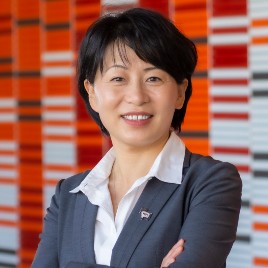A low-cost feeding device for infants, a process to break down “forever chemicals,” and an augmented reality quilt were among more than 500 innovative undergraduate research projects on display April 21 at Worcester Polytechnic Institute (WPI) during the university’s annual campus-wide celebration of senior students’ achievements.
The Undergraduate Research Projects Showcase gave about 1,145 senior students, who had worked alone or in teams for months, an opportunity to display their Major Qualifying Projects (MQP), which all students must complete to graduate. Supervised by faculty members and sometimes performed with outside sponsors, MQPs are professional-level research, design, or creative projects that seek solutions to real-world problems and reflect WPI’s leadership in project-based learning.

Grace Wang
“It is inspiring to see WPI’s students tackle real-world problems with innovation, creativity, and a great sense of social responsibility,” said Grace Wang, WPI president. “Their extraordinary accomplishments illustrate how project-based learning and WPI’s philosophy of theory and practice prepares critical thinkers, lifelong learners, and leaders who contribute to their fields and positively impact their communities.”
Undergraduate research at WPI enables students to strengthen their knowledge in their majors and work across disciplines. The university’s annual showcase of undergraduate research projects is among events featured on the website of the Council on Undergraduate Research, which supports and promotes high-quality mentored undergraduate research, scholarship, and creative inquiry.
All the research projects, including the following five projects, can be found here:




















